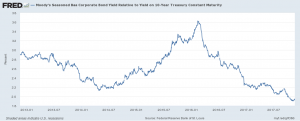American corporations have been borrowing money at a rapid clip over the last several years, bringing total corporate debt to $8.7 trillion – its highest level relative to U.S. GDP (45%) since the financial crisis. In just two years, corporations have added $1 trillion of new debt, which is the equivalent of a borrowing stampede. This issuance of new debt isn’t breaking news or the revelation of a big unknown. Corporations have been borrowing so much, so quickly for a simple reason: because they can.
For years, near-zero interest rates have left investors starving for yield, and many have turned to corporate America for better, higher yields. The increased and sustained demand for yield has allowed corporations to raise money at lower rates, with healthy corporations getting close to risk-free rates on debt. Less credit-worthy corporations are in the mix too, getting better deals for debt than they should.
The end result is that the risk premium for owning corporate bonds over U.S. Treasuries – which is another way of saying how much extra an investor gets paid for taking the additional risk of lending to a U.S. corporation versus the government – is at historic lows:
The Spread Between Corporate Bond Yields and the 10-Year U.S. Treasury is < 2%

Source: Federal Reserve Bank of St. Louis
If a company with strong earnings, sales, and high levels of free cash flow borrows money at super low rates because they want to invest and expand, and perhaps pay out an additional dividend to shareholders, no portfolio manager around here would object one bit. To those corporations we would say, borrow away! Issuing debt at 3–4% is arguably once in a lifetime.
Where we raise an eyebrow, however, is when corporations with weak cash flows and vulnerable earnings are using borrowed money to boost shareholder equity via stock buybacks, dividends, or to fund merger and acquisition activity. In those cases, where a company is not generating enough cash to pay for these activities on their own, it can be troubling – not only for that company should rates tick up, but also for the broader economy. These are the companies adding tremendously to their debt burdens while also hollowing out their equity capital, which is not a good combination. Investors should be actively screening these companies out of portfolios.
How Investors Need to React
So far, this issue has not come home to roost, and there may be some time yet before a reckoning takes place. For the past several years, firms that have been increasing their debt and buying back stock have also performed relatively well. But at the same time, there has not been any danger that interest rates would tick-up suddenly. Back then, the Fed was intent on keeping interest rates at the zero bound and quantitative easing was still in play.
Today, the calculus has changed, and we are at the cusp of a slow drift higher for interest rates. As they go up, companies with weaker balance sheets and higher debt levels will likely feel the pinch not only as interest expenses increase, but also as investors start to pivot to quality. We’re already starting to see some nascent signs of this trend – in 2017, there has been a rotation away from companies that grow earnings from issuing debt and buying back stock, to companies that are experiencing organic revenue and earnings growth. The latter are the types of companies investors are likely going to want to favor in the late stages of this bull market.
The Bottom Line for Investors
The question for investors then becomes, how do you screen companies for fundamentals like higher debt, lower free cash flows, earnings growth, and so on?
One way to do it, which is a methodology we champion here at Zacks Investment Management, is to use earnings estimate revisions to identify companies that are growing earnings due to top-line revenue growth. This metric can tell you if a company is borrowing money to boost earnings, or if they are using the money to give additional lift to earnings that are already there.
Investors should seek out companies that borrow money to expand and create more business, and who have the cash flow needed to service all of their debt in the future, even as rates rise.
To give you more insight into factors that could affect your portfolio, I invite you to download our just-released Zacks Market Strategy report free of charge by clicking on the link below.
Disclosure
Zacks Investment Management, Inc. is a wholly-owned subsidiary of Zacks Investment Research. Zacks Investment Management is an independent Registered Investment Advisory firm and acts an investment manager for individuals and institutions. Zacks Investment Research is a provider of earnings data and other financial data to institutions and to individuals.
This material is being provided for informational purposes only and nothing herein constitutes investment, legal, accounting or tax advice, or a recommendation to buy, sell or hold a security. Do not act or rely upon the information and advice given in this publication without seeking the services of competent and professional legal, tax, or accounting counsel. The information contained herein has been obtained from sources believed to be reliable but we do not guarantee accuracy or completeness. Publication and distribution of this article is not intended to create, and the information contained herein does not constitute, an attorney-client relationship. No recommendation or advice is being given as to whether any investment or strategy is suitable for a particular investor. It should not be assumed that any investments in securities, companies, sectors or markets identified and described were or will be profitable. All information is current as of the date of herein and is subject to change without notice. Any views or opinions expressed may not reflect those of the firm as a whole.